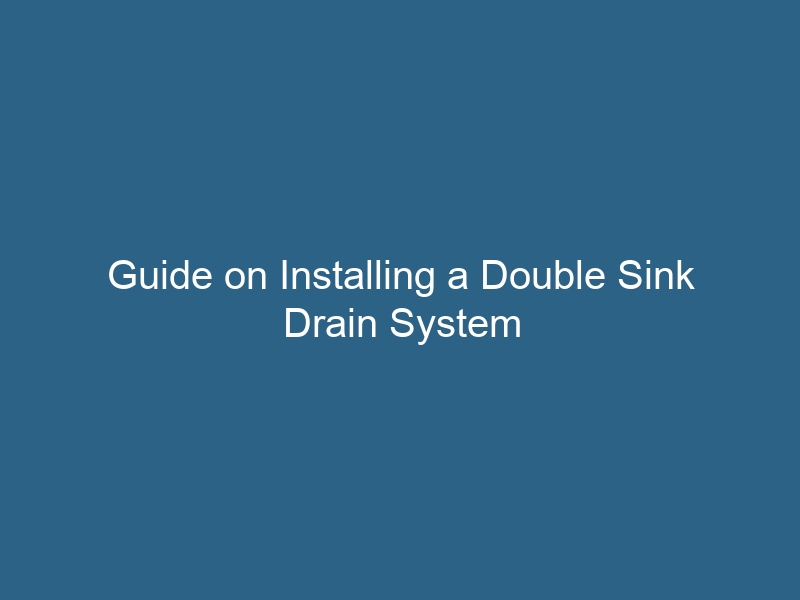Quck answer
To install a double sink drain system, follow these steps:
1. Gather the necessary tools and materials: a double sink drain kit, plumber’s putty, a hacksaw, a pipe wrench, and a bucket.
2. Turn off the water supply to the sink and remove any existing plumbing connections.
3. Install the drain assembly for each sink. Apply plumber’s putty around the drain flange and insert it into the sink’s drain hole. Secure it with the provided gasket and nut.
4. Connect the drain pipes to each sink’s drain assembly. Measure and cut the pipes to the desired length using a hacksaw. Use a pipe wrench to tighten the connections.
5. Connect the drain pipes to the main drain line. Use a trap adapter to connect the pipes to the wall drain. Ensure that all connections are tight and secure.
6. Test the system by turning on the water supply and checking for any leaks. Make any necessary adjustments or tightenings.
7. Once everything is properly connected and there are no leaks, you can use your new double sink drain system.
By following these steps, you can successfully install a double sink drain system.
Usually, the drains for a double kitchen sink connect to a single P-trap, which then connects to the drain. There are different ways to install a double sink drain, but the most common method is to extend a horizontal drain arm with a 90-degree elbow from each sink to a tee fitting that connects to the trap. When one of the sinks has a garbage disposal, the arrangement becomes slightly more complicated, but not significantly.
Parts for Connecting a Double Sink Drain
The actual drain assembly depends on where the P-trap is located in relation to both sinks. It is usually somewhere between them, and in some cases, it may align with one of the sink drains. Since the trap needs to align with the waste opening in the wall, which is difficult to move without much effort, its position is something you have to work around.
Constructing a double bowl kitchen sink plumbing diagram that starts from the trap opening and extends to the drain openings on the sinks can be helpful. This diagram will show you the types of fittings you need and the lengths of the pipes required. Typically, you will need the following fittings, as described on YouTube by Keeney:
- a drain elbow for each sink, which directs the drainage horizontally towards the trap
- a sanitary tee
- a short length of pipe to connect the tee to the trap.
All these fittings come with compression fittings that can be tightened by hand. You can choose between metal or plastic fittings, but most plumbers prefer plastic ones because they are easier to use and do not corrode. If your setup is standard, you should be able to find a double sink plumbing kit that includes everything you need.
Assembling the Drain System
- Start by installing a drain strainer assembly in each sink. Each strainer has a threaded flange on the underside where you can attach a 90-degree waste arm. Extend each arm towards the trap, ensuring a minimum slope of 1/4 inch per foot towards the trap.
- Use a hacksaw to cut each arm to the necessary length, creating a junction point directly over the P-trap opening.
- Install a sanitary tee drain connector with its sweeps pointing towards the trap. If you need to connect a dishwasher to the drain, use a tee with a dishwasher drain port.
- Connect the tee to the P-trap using a short piece of pipe.
- Tighten all the connector nuts in the assembly by hand.
- Check for leaks and use locking pliers to tighten any connectors that are leaking.
Alternate Approaches
If you have a garbage disposal, you do not need to connect a drain elbow to one of the sink drains. Instead, you can simply extend the horizontal arm from the garbage disposal waste outlet using a length of straight pipe. Since the distance between the garbage disposal outlet and the underside of the sink is fixed, you will likely need to add a vertical tailpiece to the other sink drain to align its horizontal drain at the same level.
If the plumbers had anticipated the need for a double sink during the initial installation of the drain plumbing, they might have positioned the waste outlet directly behind one of the sink drains. This arrangement simplifies the installation process, as it allows for the installation of a vertical tailpiece with a built-in tee on the sink, directly above the P-trap. In addition, a single horizontal drain can be extended from the other sink to connect to this setup.


